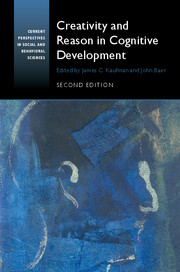Book contents
- Frontmatter
- Dedication
- Contents
- List of Contributors
- Acknowledgments
- 1 Creativity, Reason and Cognitive Development: Ten Years Later
- SECTION ONE CREATIVITY AND REASON IN CHILDHOOD AND THE SCHOOLS
- 2 Creativity in Young Children's Thought
- 3 Early Experiences and Creativity: An Ecological Perspective
- 4 Imaginative Play
- 5 Revisiting the Relationship among Schooling, Learning, and Creativity
- 6 Higher Level Thinking in Gifted Education
- 7 A Young Artist's Story: Advancing Knowledge and the Development of Artistic Talent and Creativity in Children
- SECTION TWO CREATIVITY AND REASON IN COGNITION AND NEUROSCIENCE
- SECTION THREE CREATIVITY AND REASON: INTERACTIONS AND RELATED CONSTRUCTS
- Author Index
- Subject Index
- References
2 - Creativity in Young Children's Thought
from SECTION ONE - CREATIVITY AND REASON IN CHILDHOOD AND THE SCHOOLS
Published online by Cambridge University Press: 05 February 2016
- Frontmatter
- Dedication
- Contents
- List of Contributors
- Acknowledgments
- 1 Creativity, Reason and Cognitive Development: Ten Years Later
- SECTION ONE CREATIVITY AND REASON IN CHILDHOOD AND THE SCHOOLS
- 2 Creativity in Young Children's Thought
- 3 Early Experiences and Creativity: An Ecological Perspective
- 4 Imaginative Play
- 5 Revisiting the Relationship among Schooling, Learning, and Creativity
- 6 Higher Level Thinking in Gifted Education
- 7 A Young Artist's Story: Advancing Knowledge and the Development of Artistic Talent and Creativity in Children
- SECTION TWO CREATIVITY AND REASON IN COGNITION AND NEUROSCIENCE
- SECTION THREE CREATIVITY AND REASON: INTERACTIONS AND RELATED CONSTRUCTS
- Author Index
- Subject Index
- References
Summary
Consider the following examples:
• Adam (age two and a half) was taking a bath, and his mother said, “I'm going to get the shampoo” as she reached for the bottle of shampoo, which had a cap in the form of Winnie-the-Pooh's head. Adam replied, without missing a beat, “I want sham-piglet,” pointing at the bottle of bath bubbles, which had a cap in the form of Piglet's head. (Gelman, 2003, p. viii)
• A conversation between a child (age two years) and her father:
sharon: “I pretend the sand is a birthday cake!”
father: “The sand is a birthday cake?”
sharon: “I preTEND.” (Gottfried, unpublished data)
• “The water is the fish's house.” (Sophie, age three years; we thank Sophie's father, Andrew Gelman, for supplying this example)
• “Do animals like pomegranates?” (Abe, age two years, 11 months; Gelman, 2003, p. 205)
Although this chapter concerns creativity, we do not consider ourselves to be “creativity researchers” – that is, we do not study creativity per se. Rather, we are developmental psychologists who study children's concepts. However, we argue in this chapter that young children's ordinary thought entails a considerable degree of creativity. Specifically, children organize knowledge in creative ways, from a very young age. Our main goal is to make this case with four key illustrations (paralleling the preceding examples), including (1) nonconventional language use, (2) pretense, (3) theory construction, and (4) generalizing from specifics. Although some of these cases will be familiar to those who study creativity (e.g., nonliteral language use and pretense are prototypical examples of creativity in children and are linked to creative endeavors for adults, such as poetry or theater), others are not so readily understood as displaying creativity. So part of our task is to explain why and how we consider these commonplace cognitive activities to be embedded in a creative approach to knowledge. Additionally, we hope to raise some more general questions concerning what counts as creativity, the developmental fate of creativity, and the relation between creativity and cognition more broadly.
First, a note on what we mean by “young children.” Our focus is on children who can talk but have not yet begun formal schooling, primarily two- to five-year-olds. This age group is of particular interest for several reasons.
- Type
- Chapter
- Information
- Creativity and Reason in Cognitive Development , pp. 9 - 32Publisher: Cambridge University PressPrint publication year: 2016
References
- 1
- Cited by



